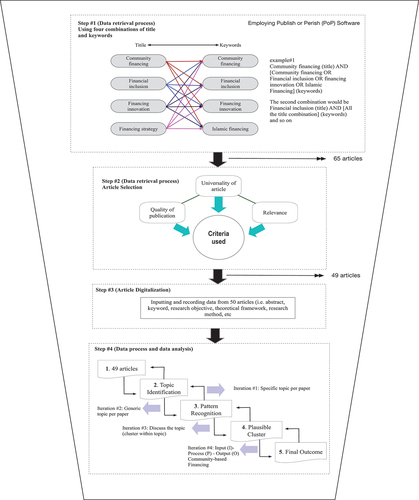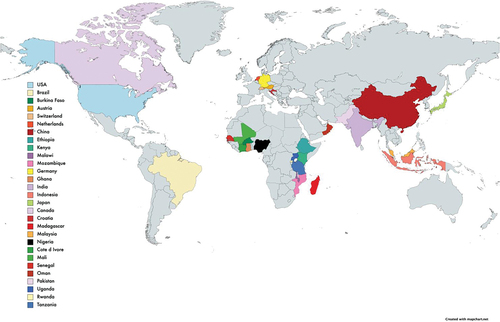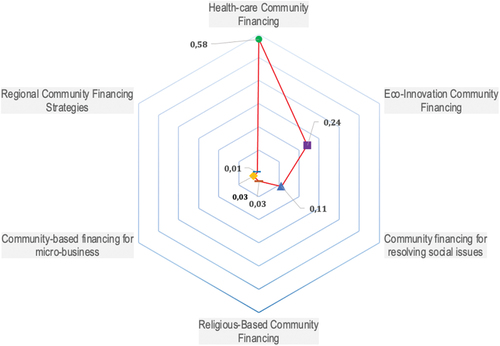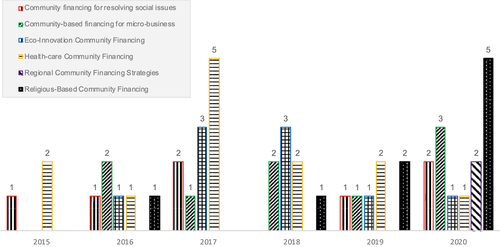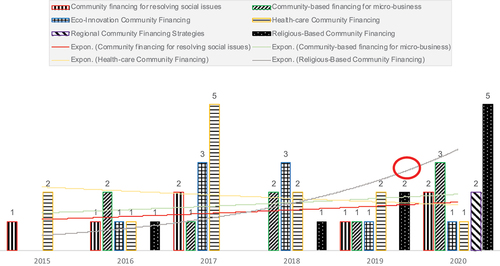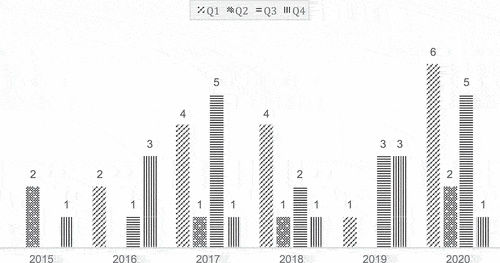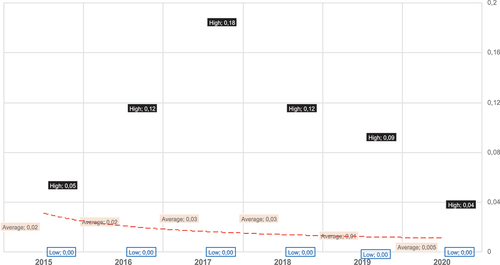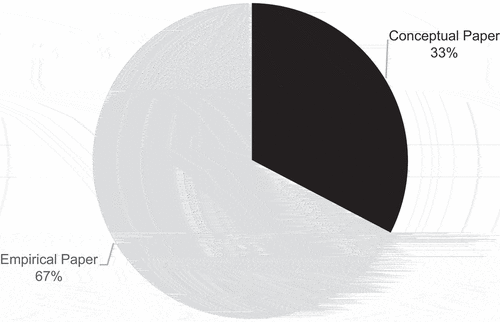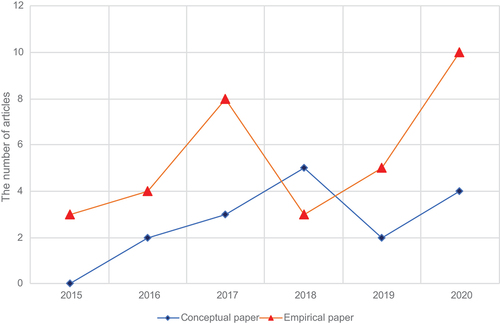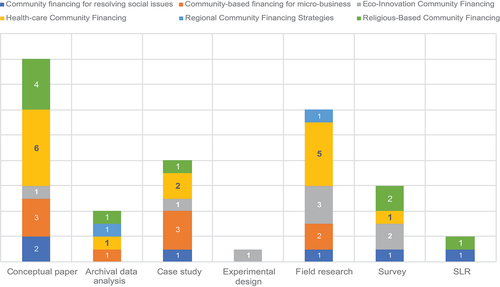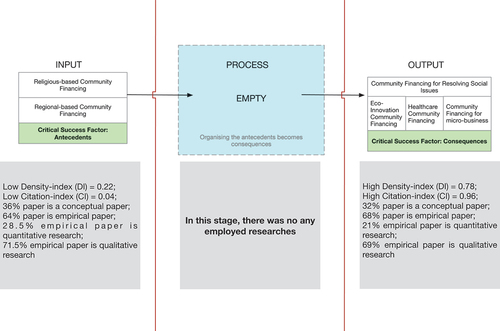Abstract
Taking into account the issues on the need for an alternative financing mechanism that can complement and provide solutions to the shortcomings of today’s conventional financing mechanisms, this cutting-edge study seeks, through a systematic review analysis, possible avenues for further research on community financing. This review disclosed that previous scholars have failed to address the area of inputs (antecedents). No study was carried out on the processes in the Input-Process-Output/Outcome (IPO) framework. These findings provide ground-breaking information that clarifies the directions of future research. This systematic review employs a combination of a quantitative and qualitative approach to pull together studies on community financing. Involving four stages of data retrieval, article selection, data tabulation, and data analysis by using Publish or Perish (PoP) software. After selecting articles based on the relevance, universality, and quality of the publication, this work employs content analysis to classify articles’ topics. This research was restricted to study articles that were indexed by the Scopus and Web of Science (WoS) database that ranged from 2010 to 2021. The result of this research gives an insight to many scholars who want to give more attention to forthcoming research in the field of community financing. Besides, it preserves policymakers as a reference to establish alternative sources of financing by figuring out how community financing works are.
1. Introduction
As widely acknowledged, the financial sector plays a critical role in the economic success of a country. Most policymakers on economics have insisted as well as concerned to assure the stability, particularly the liquidity of this sector. As most of us are aware, Indonesia suffered a severe economic crisis in 1998 as a result of the collapse of financial sectors. The collapse of those led to some economic actors suffering a liquidity crisis, the collapse of the business, and ultimately a downturn in the state of the economy. In the last few years, the discussion pertaining to building a strong financial sector has been very intriguing. Some scholars have established a financial mechanism that is resilient and decreases systematic risk. For instance, Forson (Citation2020) proposed that the future of financial mechanisms would be built on a community that raises, crowdsource, and consume the funds independently. In general, such a mechanism provides advantages, especially for fulfilling liquidity demands that have not been established by the government. Furthermore, since the funds may only be circulated inside the community, this mechanism might guarantee a lessening of the systemic risk.
Based on its literal meaning, community financing (or community-based financing) is the financing initiated and coordinated by some interconnecting societies in a community. This financial model enables a close relationship between lenders (investors) and debtors (consumers). In terms of risk reduction, the non-performing financing, which has been a threat to the financial industry, could be alleviated. Therefore, the liquidity problem, which has been a further huge concern of the banking industry, can be simply resolved. Perrin (Citation2017) argued that the current matter of social protections, such as the expenses for healthcare services and education, could be overcome through community financing. Gopalan and Durairaj (Citation2015) and Lu et al. (Citation2016) shown that community-based financing increase funding for healthcare and child stunting in India and Rwanda. Broughel and Hampl (Citation2018) also offered empirical support for the pivotal role of community-based financing in establishing a source of renewable energy in Austria and Swiss.
Concern about how community financing enhances and strengthens social protection has particularly drawn attention to research in the field of community financing (i.e., healthcare, education, housing). The acceptance of such activities for societies with curtailed access to funds is crucial. Hence, this study broaches the usefulness of community financing. At least, community financing could resolve the issue of financial inclusion for lower-middle-income societies. However, given how important this is, the most current research on this subject is still insufficient. Based on the literature on reputable journals that have been indexed by the Scopus from 2015 to 2020, there are only 65 articles that specifically discuss community financing.
This systematic literature review on community financing delineates to what extent the topic has been discussed. The finding would be valuable for delving deeply into the discussion of potential avenues for further study on community financing. The systematic literature review has four stages namely data retrieval, article selection, data tabulation, and data analysis. The method employs a qualitative interpretive process to meet the following two questions:
Q1. What current themes regarding community financing are being discussed?
Q2. What factors determine the establishment of community-based financing?
Q3. What are community-based financing for?
Q4. What are the less-examined issues on community financing in the literature now available as a starting point for further research avenues?
There are five sections to this paper. The first section presents the background as well as the objective of this study, which makes the case for why this study should be conducted based on the four underlying research questions. The second section unfolds the method of this systematic literature review, including interpretation of the four stages of data retrieval, article selection, data tabulation, and data analysis. The third and fourth sections expound comprehensive results of the study as well as establish what further avenues may be employed for further research. A detailed conclusion of the systematic literature review research is provided in the fifth section.
2. Method
This study combines quantitative and qualitative approaches to answer research questions. This is involved in bibliographical research that inquiries current literature on particular subjects. In a quantitative approach, the systematic literature review pools and describes previous studies in the field of community financing. Meanwhile, in the qualitative approach, this research occupies an interpretive content analysis of previous literature to seek specific sub topic about the work of earlier researchers and to determine what further research avenues to be pursued. This systematic literature review research refers to Indarti et al. (Citation2020), Bramer et al. (Citation2017); Moher et al. (Citation2015); Siddaway et al. (Citation2019).
The systematic literature review in this study consisted of four stages, such as data retrieval process, article selection, article data tabulation, and data analysis, as depicted in Figure . The description of each stage as follows:
2.1. Stage 1. Data Retrieval
The first stage of the systematic literature review involved seeking and retrieving current studies on community financing. This work retrieved articles from Scopus, and Web of Science database with employed keywords such as “community financing”, “financial inclusion”, “financing innovation”, “financing strategy”, and “Islamic financing”. In the process of retrieving articles, this literature study utilizes the Publish or Perish (PoP). PoP is a software that aids researchers in examining and assessing their scientific publications. It employs publication data from online academic data sources to determine the number of publications released by a researcher, along with their h-index and i10-index.
2.2. Stage 2. Article selection
To ensure the review’s quality and validity, this paper used selection criteria such as relevance, quality of the publication, and article universality. The universality of the article is embodied by the article written in English, whereas the quality of the publication is depicted by the index in SCImago Journal Rank (SJR) and its classification as a non-predatory journal (based on: www.beallslist.weebly.com).
2.3. Stage 3. Data tabulation
In this stage, data from selected articles, such as abstract, theories, keywords, research objective, methodologies, research setting, and research results were tabulated. The data are needed as the main requirement for data analysis.
2.4. Stage 4. Data analysis
The systematic literature review in this paper employs interpretive content analysis to deduce and assign a topic to each selected article. The analysis comprises four stages including (1) employing content analysis to identify the selected articles based on their abstract, research objective, research questions, and research result, thereafter, the selected article will be grouped based on common topics of discussion; (2) examining any possible trend within each related issue, then developing further discussion to properly represent each pattern; (3) evaluating the selected articles to determine whether any patterns are feasible and to draw more discussion from each topic to establish a baseline for each theme; (4) analyzing data by input-process-output (IPO) approach based on the baseline.
To ensure the objectivity of research findings, this study employed an iteration process (iteration 1 to 4) in data analysis. These stages are depicted in Figure in results section.
3. Results
3.1. Data retrieval
According to the process, the study obtained 65 articles which related to the issue. Articles retrieved were selected based on their relevance, quality of the publication, and universality of the article.
3.2. Article selection
Based on three criterias such as, quality of publication, universality of article, and relevance, 49 articles were selected from the initial pool of 65 articles, many of which are articles from reputable journals (Quartile 1 = 17; Quartile 2 = 6; Quartile 3 = 16; Quartile 4 = 10), as we have known that Scopus places significant importance on the relevance of journals, which has led to a categorization of journals based on their Q-ranking. This ranking system divides journals into four quartiles, ranging from Q1 (highest) to Q4 (lowest). The top two quartiles, Q1 and Q2, contain the most respected journals. The placement of a journal in a particular quartile is determined through scientometric calculations that consider the number of citations, which are then converted into percentages. All papers were published between 2015 and 2020. The year 2015 served as the beginning point for retrieving the associated articles due to the commencement point for the literature review for several reasons. Firstly, it was linked to the global financial crisis that transpired in 2008. As a consequence of this crisis, which was instigated by conventional financial institutions, researchers hypothesized that many scholars would contemplate introducing alternative financing mechanisms besides the existing conventional mechanisms. Secondly, the reason why the study did not commence with articles published in 2009 is that, upon conducting keyword searches, it was found that there were hardly any articles from reputable international journals that specifically addressed the subject of community financing between 2009 and 2014. Lastly, the review was concluded with articles published up until 2020 as no articles matching the keyword criteria were identified in the subsequent years of 2021, 2022, and 2023.
3.3. Data tabulation and data analysis
The data analysis in this literature study is based on the tabulation of data that has been conducted. The data tabulation process is based on the abstraction, keywords, theory, research methods, and results of the selected articles. The data analysis includes content analysis of the 49 articles to determine the themes that have been researched and trends of these themes in recent years.
As explained in the previous section, this literature analysis process consists of a series of iterative steps. The iteration process is illustrated in Figure below:
3.4. Research trends in the field of community financing
This paper examined 65 articles in light of the analysis on predetermined criteria, then identified 49 selected articles. Selected articles were analyzed through content analysis for interpretive themes. The selected papers were grouped into six clusters of themes based on the relatedness among articles, such as healthcare community financing, eco-innovation community financing, community-based financing for micro-business, community-based financing for resolving other social issues, religious-based community financing, and regional community financing.
Figure shows the research setting of 49 selected articles. Studies on community financing were dominantly carried out in least developed and developing countries, such as Malaysia, Indonesia, Croatia, Oman, Pakistan, India, Rwanda, Nigeria, Burkina Faso, Uganda, Ghana, Malawi, Mali, Madagascar, Tanzania, Senegal, etc. These are not surprising given that the issues of economic inequality, social disparity, and public services optimization have all been pressing issues requiring to be resolved immediately.
Each cluster has sub-themes. The citation level was measured by the citation per article divided by the total citation of each topic. It was identified that the top three topics by citation level are healthcare community financing (citation level = 0.58), eco-innovation community financing (citation level = 0.24), and community-based financing for resolving other social issues (citation level = 0.11). Figure illustrates citation levels for all topics determined.
Meanwhile, the bottom three of selected topics are community-based financing for micro-business (citation level = 0.03), religious-based community financing (citation level = 0.03), and regional community financing (citation level = 0.01). This finding is not shocking given that the early discussion of community financing was sparked by the social disparity in many different parts of the world, such as the provision of public services (i.e., healthcare, education, energy). The description of each cluster of themes is scrutinized in this section.
First, healthcare community financing is a mechanism to cover health care costs with an innovative financing strategy that is independently established by society (Graaf & Snowden, Citation2017; Noor et al., Citation2019; Renggli et al., Citation2019; Shapira et al., Citation2018; Snowden et al., Citation2017; Ssebunnya et al., Citation2018; Turcotte-Tremblay et al., Citation2017). It was designed to address issues such as poor investment in healthcare, lack of health financing policy, limited financial access to health services, limited health insurance coverage, and inadequate budgeting from the government (Tapas & Pillai, Citation2017). For instance, a qualitative study conducted by Kumar et al. (Citation2020) investigated policy initiation for universal health coverage (UFC), which is a scheme of community-based financing for large-scale health program in Kenya, Malawi, Mozambique, and Ethiopia. The study discovered that low- and middle-income countries have limited UFC at all levels. Their study serves two indispensable pieces of evidence, (1) health care cost has been an urgent issue in low and middle-income countries, and (2) Community financing in low- and middle-income countries has not proven satisfactory. These contrast substantially with high-income countries (i.e., the United States). Lapidos et al. (Citation2019) examined the value of sustainability financing for community health workers. The study discovered new potential opportunities for sustainable financing of such activity. We may infer from the two separate research settings that the challenges in low- and middle-income countries revolved around raising awareness to initiate community financing. Meanwhile, in high-income countries, discussions are pertaining to the contemporary sustainable value of community financings, such as synthesizing innovative databases for supporting healthcare community financing (Hennessy et al., Citation2015) and innovative healthcare community financing (Perrin, Citation2017).
Second, eco-innovation community financing is a financial mechanism that was directed toward developing renewable energy and protecting the environment. The sub-topics were around animal conservation and water conservation (Chaplin & Legge, Citation2019; Foster, Citation2017), post-disaster environment reconstruction (Xiao et al., Citation2020), and forest preservation and renewable energy policy project (Albertario, Citation2016; Broughel & Hampl, Citation2018; Hulsink & Scholten, Citation2017; Mechik et al., Citation2017; Vianna et al., Citation2018; Yoshino & Taghizadeh-Hesary, Citation2018). The sub-topics of renewable energy policy projects were dominantly undertaken in most high-income countries (i.e. the United States, China, Japan, Switzerland, Netherlands). Broughel and Hampl (Citation2018) examined socio-demographic factors affecting society to involve in investment programs for the renewable energy projects. This survey found that in contrast to low- and middle-income societies, higher-income societies were more likely to be open to investing 1,000–10,000 EUR in renewable energy projects. While in low- and middle-income countries, the main focuses of eco-innovation community financing were on wildlife conservation, water conservation, and forest preservation. Foster (Citation2017) explored how community financing has worked on community water services in Kenya. By simulating 43,020 household payments during 26 years, his research proposed an economic model that demonstrated the minimal requirement of actively involved communities in purchasing water services. Vianna et al. (Citation2018) surveyed the economic potential of shark-diving tourism in Malaysia for developing a new financing mechanism for future shark conservation. The findings indicated the possibility of opportunities to generate community financing to support the activity.
Third, community financing for resolving social issues is a financial mechanism to overcome other social problems, excluding healthcare and eco-innovation (Karra et al., Citation2016; Petross et al., Citation2020). The sub-topics were related to housing financing (Sayuti et al., Citation2020) and education for poor societies (Petrushenko et al., Citation2017). In Gorontalo, Indonesia, Puadah (Citation2019) employed a mixed method to investigate community participation in funding education costs, and the results revealed a decline in such participation as a result of the Indonesian government’s School Operational Assistance (BOS) program. This research would be a fascinating phenomenon since it would show how community finance mechanisms were obviously at odds with government programs. Related to the housing issue, Acheampong and Anokye (Citation2015) gave insight into the Ghanaian housing market. The study discovered that low-income households had significant difficulties obtaining housing financing. The study offers a conceptual framework for developing community-supported alternatives for house financing.
Fourth, community-based financing for micro-business is a viable financial option that, for the most part, offers capital security services and improves business performance on an independent basis (Babajide et al., Citation2020; Chandrarin et al., Citation2018; Magomedova et al., Citation2020; Mwamba et al., Citation2017; Obetta & Oreh, Citation2017; Pomeroy et al., Citation2020; Yue et al., Citation2019).
Fifth, religious-based community financing is a financing mechanism established by the religious community, in which the regulation of such mechanism has always adhered to their holy book of Qur’an and hadith in Islam (Al Balushi et al., Citation2019; Hassan & Manap, Citation2020; Rahman et al., Citation2020). The issue of Islamic financing as an alternative financing mechanism dominated the majority of subtopics. Zauro et al. (Citation2020) and Zauro et al. (Citation2016) proposed the integration of waqf management for enhancing financial inclusion and socio-economics justice in Nigeria. Using a rigorous conceptual framework, Nienhaus (Citation2018) argued that the instrument of waqf could be alternative capital source for financing social expenditures. Waqf is one of Islam’s religious instruments, and it refers to any activity that increases the use of an asset (such as land or money) while maintaining the wakif‘s ownership of that resource .Footnote1
Lastly, the theme of regional community financing was concerned with the issue of coordinating the regions, whether they were in the same country or in separate countries, to enhance social and economic performance through community financing. In this regard, Forson (Citation2020) examined the regional bloc of the African Union (AU) that implemented ECOWAS, the economic program that was concerned on three policy instruments such as institutional framework, financing, and interaction. The findings demonstrated that the members actively supported financial and institutional policies through investments in research, technology, and innovation.
Based on Figure and Table , regional community financing was overlooked by the scholars as indicated by the citation index (CI) of 0.01 and density index (DI) of 0.04. Table shows the density index (DI) of the topics along with their sub-topics, which is measured by dividing the total number of articles into the subtopics by the total number of articles in the topic.
Table 1. Density-Index
Healthcare community financing has the highest density index (DI: 0.27 and the number of articles: 13). it implies that this topic is more thoroughly studied by academics than other topics. Regional community financing has the fewest density index (DI: 0.04 and the number of articles: 2), the topic has not been explored in-depth and may yet have some unresolved issues that need to be explored more. Meanwhile, Figure shows the trend of the topic each year.
A close look at Figure reveals the topics that were distributed throughout the previous six years. It is obvious from the data that healthcare community financing has consistently been a popular issue. After that, other topics were addressed, including, eco-innovation community financing, community financing for micro-business, community financing for resolving social issues, and religious-based community financing. According to the data, regional community financing has received very little attention during the past six years (only in 2020). Figure displays the trendline for each topic over the previous six years.
Despite healthcare community financing, eco-innovation community financing, community financing for micro-business, community financing for resolving social issues, and religious-based community financing being studied every year, the themes exhibit a negative trendline. Consider Figure , only religious-based community financing has an exponential trendline with positive values. It follows that over the past six years, this topic has piqued the curiosity of scholars.
Following that, Figure illustrates article classification with their reputable Scopus index.
Articles on community financing are classified as follows: Q1 = 17 (35%) Q2 = 6 (12%) Q3 = 16 (33%), and Q4 = 10 (20%). The result that 35% of publications were indexed in Scopus-quartile 1 (Q1) suggested that community funding is a very important and compelling issue, particularly for scholars of financial discourse.
Figure displays the trend of the citation index of overall topics in community financing. The graph illustrates the citation index’s declining trend from 2015 to 2020, and from this depiction, we may infer researchers’ interest in this area. As indicated by the statistics, scholars’ attention on these topics was waning, but this was in contrast with the upward trend in the number of publications produced from 2015 to 2020 (citation-index trend < published article). The idea that the number of papers published is higher than the citation index suggests that researchers did not give the current topics in community financing more attention, and as a result, these topics have not been thoroughly examined.
3.5. The trend of research methodology in community financing
This section accords the growth and spread of community financing research methodology from 2015 to 2020. Based on our collected data, in general, the published articles in such fields cover both conceptual and empirical approaches. Figure shows the distribution of published articles considering their type.
In Figure , we can see the distribution of article types in the selected papers. Conceptual papers accounted for 33% of the total, whereas empirical papers made up the remaining 67%. While the chart provides empirical evidence that the study of community financing is dominated by empirical papers, it also shows that there are a significant number of conceptual works in this area. Interestingly based on Figure , more conceptual papers were published in 2018 than empirical articles, indicating that community financing studies continue to find conceptual papers to be intriguing.
Based on the sum of the articles in Table , 16 conceptual papers were carried out in the period from 2015 to 2020.
Table 2. Research Approach
Additionally, Table elaborates the details of the research approach, which encompassed both a qualitative and a quantitative approach. Based on the selected paper, the qualitative approach consists of field research and case studies. Meanwhile, in the quantitative approach, there were surveys, archival data analysis, experimental design, and systematic literature review (SLR). The table also provides data on research approaches and research designs. Based on the analysis, 20 papers used a qualitative method, including 12 articles of field research and 8 articles of case studies. Meanwhile, 13 papers used a quantitative approach, including 6 surveys, 4 archival data analyses, 2 SLR, and 1 experimental design. The selected articles typically covered a ratio of 26.53 % quantitative approach, 40.81 % qualitative approach, and 32.65 % conceptual article. Table provides a detailed explanation of the research method.
Table 3. Density Index
Over the past six years, conceptual papers have typically dominated Research on community financing (32.65%). The issue that was raised using this method was primarily driven by the introduction of new ideas on the development of community financing. Nienhaus (Citation2018) and Zauro et al. (Citation2020) proposed a strategy to develop waqf as a pivotal instrument to rise financial accessibility and socioeconomic. Yue et al. (Citation2019) descriptively argued that microfinance institutions potentially overcome current problems upon financial inclusion and become the future of financial institutions, rising financial justice for any layers of society. Perrin (Citation2017) particularly advocated the possibility of innovative healthcare financing based on the community. The paper placed special emphasis on the mechanisms of value-based insurance design and purchasing, which aim to improve and maximize the effectiveness of healthcare services and outcomes for society.
Table depicts that field research predominated over other research methods among publications on community financing. Figure illustrates the distribution of research approaches in empirical research papers.
Figure shows that empirical research papers consisted of 37% of field research approaches, 24% of case studies, 18% of surveys, 12% of archival data analysis, 6% of systematic literature review (SLR), and 3% of experimental designs. For instance, Pomeroy et al. (Citation2020) disclosed the significant impact of community financing in fishing communities using a field research approach, Forson (Citation2020) employed the same approach to find out how the Economic Community of West African States (ECOWAS) was implemented in several African countries. Babajide et al. (Citation2020) applied a case study to discover how to develop financial technology based on community financing to finance small-medium enterprises (SMEs) in Nigeria. Noor et al. (Citation2019) carried out a survey to learn what Malaysians think about healthcare community finance and what they want. According to the survey, 87.5% of Malaysians showed enthusiasm and interest in taking part in the health care community financing.
Figure displays how each sub-theme in the discourse of community financing was addressed, as well as the methods and approaches used thus far. It is evident how prior discussions were still mostly focused on conceptual papers. The proportion of conceptual articles outperformed empirical articles in each sub-theme. For instance, under the sub-theme of religious-based community financing, the number of conceptual papers outpaced the number of archival data analysis publications. Likewise, when compared with the case study approach in the same sub-theme, the ratio of comparison was 4:1. Indeed, these have interesting practical implications, especially in the framework of upcoming research, which will be comprehensively discussed in the future.
4. Discussion: What are future research avenues?
Departing from the prior data analysis results, the input-process-output (IPO) approach was further used to interpret content analysis. This approach aims to find and classify the topics of previous research on community financing into input stage (I), process stage (P), and output stage (O). The analysis helps to show the current roadmap of research on community financing both practically and theoretically. The input stage (I) reflects the antecedent of the signified underlying factors of the establishment of community financing. So, it facilitated to answer the our second research questions. Process stage (P) explains how the underlying factors of the establishment of community financing work. While output process (O) defines the impact of community financing on any layer of society, which was useful for answering third research questions. Figure shows the result of the IPO approach toward many current topics in research regarding community financing.
Religious-based community financing and regional community financing are classified into input stages. Similarity, in religious tenets and geographical ties were previously highlighted as potential precursors for the creation of community financing. Khan et al. (Citation2021) found that the affinity of religious principal spirits in Pakistan has been the driving force behind the establishment of successful community financing for housing loans. Forson (Citation2020) discovered that ECOWAS community financing in Africa was ignited by the regional equality between West African countries. Khan et al. (Citation2021) and Forson (Citation2020), explicitly serve empirical evidence of the important role that regional origin and proximity to religious principles have in the development of community financing.
Regarding the procedural stage of the current examination of community financing, this study discovered several intriguing insights (see Figure ). No sub-topic could be classified into such a stage. In other words, there has not yet been any research done to particularly analyze the process of community financing. Meanwhile, there were four subtopics categorized into the output stage, such as community financing for resolving social issues, eco-innovation community financing, healthcare community financing, and community financing for micro-business. Puadah (Citation2019) argues that community financing is useful for addressing education financing difficulties in Gorontalo, Indonesia. Broughel and Hampl (Citation2018) further proffer that community financing is worthy to scale up the financing project on renewable energy in Austria and Switzerland. Feldman (Citation2018) provides an example of how community financing through a local stock mechanism is employed to raise capital for manufacturing in the North Carolina Plan. Kumar et al. (Citation2020) describe that the success of universal health coverage in many African countries was boosted by community financing. The four studies examine how community financing may help to solve a variety of social issues that are ingrained in everyday community life.
Figure shows the characteristics of an IPO for each stage. These characteristics include several quantitative indicators, including density index (DI), citation index (CI), percentage of research types, and percentage of research designs for each stage. It is necessary to carefully consider the attribute’s presentation to see how well previous researchers have developed each stage of IPO. Based on the result, the input (I) stage relatively has a low-density index (0.22) and low citation index (0.04). It denotes that research in this field was not often conducted. From that evidence, further research on the input stage of community financing is therefore required. Meanwhile, by research types and designs, the input stage (I) was dominated by empirical research (28.5%) with qualitative research design (71.5%). The output (O) stage was the highest density index and citation index (DI = 0.78 and CI = 0.96) in the field of community financing. This indicates that many scholars have been more concerned about the effects of community financing throughout time. The research at the output stage (O) was dominated by empirical research with qualitative research design (60,6%). We may thus conclude that future studies should focus on stages like the input stage and process stage that have not yet been given enough attention.
5. Conclusion
This study has disclosed community-financing-related topics that have not received considerable examination such as those related to antecedent variables as the basis for establishing community financing (input stage) as well as the relation of the process of each antecedent variable in forming community financing (process stage) as indicated by their low density index (DI) and citation index (CI). This study found no research on the process of the establishment of community financing (process stage). The study undertaken so far has been too focused on themes classified in the output stage discussing issues related to the impact of community financing. This was shown by the high-density index (DI) and citation index (CI) compared to other categories (input and process). Additionally, when it comes to the study methodology, a qualitative approach was frequently adopted by researchers (>50%).
Indeed, the results of this study pave the way to the development of research on community financing by suggesting future avenues to be taken for upcoming studies. Based on these findings, further study are encouraged to be conducted to expound on the issue of antecedent variables that influenced as well as built community financing establishment. In addition, further study should focus on the process stage, such as how the running of community financing and how the mechanism of antecedent variables interacts and processes, both with other antecedent variables and with potential variables, in shaping the output and outcome of community-based financing.
The results of this study also indicate that the types of papers in the field of community financing have a disproportionately high number of conceptual studies (>30%). The proportion should be balanced by publishing more empirical studies. Accordingly, from a methodological perspective, previous studies on community financing were largely dominated by qualitative approaches. This study encourages quantitative approach to be used to transform qualitative works to acquire objectivity and generality. Therefore, future research on community financing should place a greater emphasis on quantitative design. So that future research results can significantly contribute to the practical formation and development of community-based financing mechanisms.
Disclosure statement
No potential conflict of interest was reported by the authors.
Notes
1. Wakif is a person who makes his asset available for public utilization.
References
- Acheampong, R. A., & Anokye, P. A. (2015). Housing for the urban poor: Towards alternative financing strategies for low-income housing development in Ghana. International Development Planning Review, 37(4), 445–18. https://doi.org/10.3828/idpr.2015.29
- Al Balushi, Y., Locke, S., & Boulanouar, Z. (2019). Omani SME perceptions towards Islamic financing systems. Qualitative Research in Financial Markets, 11(4), 369–386. https://doi.org/10.1108/QRFM-06-2018-0078
- Albertario, P. (2016). System of self-financing strategy for the policies aimed at the eco-innovation in the productive sectors. Procedia Environmental Science, Engineering and Management, 3(1), 8–11.
- Babajide, A. A., Oluwaseye, E. O., Lawal, A. I., & Isibor, A. A. (2020). Financial technology, financial inclusion and MSME’s financing in the South-West of Nigeria. Academy of Entrepreneurship Journal, 26(3), 1–17.
- Bramer, W. M., Rethlefsen, M. L., Kleijnen, J., & Franco, O. H. (2017). Optimal database combinations for literature searches in systematic reviews: A prospective exploratory study. Systematic Reviews, 6(1), 1–12. https://doi.org/10.1186/s13643-017-0644-y
- Broughel, A. E., & Hampl, N. (2018). Community financing of renewable energy projects in Austria and Switzerland: Profiles of potential investors. Energy Policy, 123, 722–736. https://doi.org/10.1016/j.enpol.2018.08.054
- Chandrarin, G., Sanusi, A., Imron, A., & Yuniarti, S. (2018). An empirical study on income equality, economic growth and financial inclusion in Indonesia: Model development on SMEs financing. International Journal of Education Economics and Development, 9(4), 346–365. https://doi.org/10.1504/IJEED.2018.096056
- Chaplin, H., & Legge, H. (2019). Financing and design innovation in rural domestic rainwater harvesting in Madagascar. Waterlines, 38(2), 113–122. https://doi.org/10.3362/1756-3488.18-00033
- Feldman, M. (2018). Financing a future: Investing in communities and keeping profits local. Scienze Regionali, 17(2), 145–166.
- Forson, J. A. (2020). Innovation financing and public policy dilemmas in the Economic Community of West African States (ECOWAS). African Journal of Science, Technology, Innovation and Development, 12(1), 1–11. https://doi.org/10.1080/20421338.2019.1599575
- Foster, T. (2017). A critical mass analysis of community-based financing of water services in rural Kenya. Water Resources and Rural Development, 10, 1–13. https://doi.org/10.1016/j.wrr.2017.04.003
- Gopalan, S. S., & Durairaj, V. (2015). Leveraging community-based financing for women’s nonmaternal health care: experiences of rural Indian women. Asia Pacific Journal of Public Health, 27(2), NP1144–1160. https://doi.org/10.1177/1010539511433813
- Graaf, G., & Snowden, L. (2017). The role of medicaid home and community-based services policies in organizing and financing care for children with severe emotional disturbance.
- Hassan, R., & Manap, A. N. (2020). A systematic review of factors influencing the adoption of conventional and Islamic syndicated bank financing. European Journal of Molecular & Clinical Medicine, 7(8), 1549–1568.
- Hennessy, D., Sanmartin, C., Eftekhary, S., Plager, L., Jones, J., & Onate, K. (2015). Creating a synthetic database for use in microsimulation models to investigate alternative health care financing strategies in Canada. International Journal of Microsimulation, 8(3), 41–74. https://doi.org/10.34196/ijm.00121
- Hulsink, W., & Scholten, V. (2017). Dedicated funding for leasing and sharing research and test facilities and its impact on innovation, follow-on financing and growth of biotech start-ups: The Mibiton case. Venture Capital, 19(1–2), 95–118. https://doi.org/10.1080/13691066.2017.1261454
- Indarti, N., Lukito-Budi, A. S., & Islam, A. M. (2020). A systematic review of halal supply chain research: To where shall we go? Journal of Islamic Marketing, 12(9), 1930–1949. https://doi.org/10.1108/JIMA-05-2020-0161
- Karra, M., Canning, D., Hu, J., Ali, M., & Lissner, C. (2016). Community‐based financing of family planning in developing countries: A systematic review. Studies in Family Planning, 47(4), 325–339. https://doi.org/10.1111/sifp.12000
- Khan, M. Y., Ud Din, S., Khan, M. J., & Javeed, A. (2021). Dynamics of selecting Islamic home financing. International Journal of Finance & Economics, 26(4), 5005–5016. https://doi.org/10.1002/ijfe.2051
- Kumar, M. B., Taegtmeyer, M., Madan, J., Ndima, S., Chikaphupha, K., Kea, A., & Barasa, E. (2020). How do decision-makers use evidence in community health policy and financing decisions? A qualitative study and conceptual framework in four African countries. Health Policy and Planning, 35(7), 799–809. https://doi.org/10.1093/heapol/czaa027
- Lapidos, A., Lapedis, J., & Heisler, M. (2019). Realizing the value of community health workers-new opportunities for sustainable financing. The New England Journal of Medicine, 380(21), 1990–1992. https://doi.org/10.1056/NEJMp1815382
- Lu, C., Mejía-Guevara, I., Hill, K., Farmer, P., Subramanian, S., & Binagwaho, A. (2016). Community-based health financing and child stunting in rural Rwanda. American Journal of Public Health, 106(1), 49–55. https://doi.org/10.2105/AJPH.2015.302913
- Magomedova, N., Roig, L., & Bastida-Vialcanet, R. (2020). La innovación aplicada a la financiación de las empresas de la economía social. El caso de las inversiones de impacto. CIRIEC-España, revista de economía pública, social y cooperativa, (98), 127. https://doi.org/10.7203/CIRIEC-E.98.13212
- Mechik, E., von Hauff, M., De Moura, L., & Held, H. (2017). Analysis of the changes in economic activities of Brazilian forest communities after methodical support and provision of pre-financing capital. Journal of Tropical Forest Science, 29(2), 227–237.
- Moher, D., Shamseer, L., Clarke, M., Ghersi, D., Liberati, A., Petticrew, M., Stewart, L. A. … Stewart, L. A. (2015). Preferred reporting items for systematic review and meta-analysis protocols (PRISMA-P) 2015 statement. Systematic Reviews, 4(1), 1–9. https://doi.org/10.1186/2046-4053-4-1
- Mwamba, N., Massawe, N., & Komba, K. (2017). Financial Sector Development and Financial Inclusion. In B. Ndulu, S. A. Christopher, & C. Paul (Eds.), Tanzania: The Path to Prosperitz. Oxford. https://doi.org/10.1093/acprof:oso/9780198704812.003.0012
- Nienhaus, V. (2018). Awqāf: Social spending, development strategy and financing. Journal of King Abdulaziz University: Islamic Economics, 31(2), 91–99.
- Noor, A. A., Saperi, S., & Aljunid, S. (2019). The Malaysian community’s acceptance and willingness to pay for a national health financing scheme. Public Health, 175, 129–137. https://doi.org/10.1016/j.puhe.2019.07.008
- Obetta, C. K., & Oreh, C. I. (2017). Utilising planning and financing strategies in the management of community development projects in Enugu State, Nigeria. Africa Education Review, 14(3–4), 52–66. https://doi.org/10.1080/18146627.2016.1224565
- Perrin, J. M. (2017). Innovative health care financing strategies for children and youth with special health care needs. Pediatrics, 139(Supplement 2), S85–88. https://doi.org/10.1542/peds.2016-2786B
- Petross, C., McMahon, S., Lohmann, J., Chase, R. P., Muula, A. S., & De Allegri, M. (2020). Intended and unintended effects: Community perspectives on a performance-based financing programme in Malawi. BMJ Global Health, 5(4), e001894. https://doi.org/10.1136/bmjgh-2019-001894
- Petrushenko, Y., Kostyuchenko, N., Smolennikov, D., & Vorontsova, A. (2017). Impact of the participatory financing of international development projects on social capital of the local communities. Problems and Perspectives in Management, 15(3), 183–192. (contin. 1)). https://doi.org/10.21511/ppm.15(3-1).2017.02
- Pomeroy, R., Arango, C., Lomboy, C. G., & Box, S. (2020). Financial inclusion to build economic resilience in small-scale fisheries. Marine Policy, 118, 103982. https://doi.org/10.1016/j.marpol.2020.103982
- Puadah, P. (2019). The dynamics of community and parents participation: huyula culture approach in educational financing in high schools, vocational schools and Madrasah Aliyah (Islamic High Schools) in Gorontalo Province, Indonesia. Proceedings of International Conference on Industrial Engineering and Operations Management. Universitas Negeri Gorontalo, Indonesia
- Rahman, A. A., Nor, S. M., & Salmat, M. F. (2020). The application of venture capital strategies to musharakah financing. Journal of Islamic Accounting and Business Research, 11(4), 827–844.
- Renggli, S., Mayumana, I., Mshana, C., Mboya, D., Kessy, F., Tediosi, F., Lengeler, C. … Lengeler, C. (2019). Looking at the bigger picture: How the wider health financing context affects the implementation of the Tanzanian Community Health Funds. Health Policy and Planning, 34(1), 12–23. https://doi.org/10.1093/heapol/czy091
- Sayuti, K. M., Amin, H., Razak, D. A., & Rizal, H. (2020). Receptiveness of Islamic home financing among Malaysians: A Revisit. International Journal of Business and Society, 21(2), 784–802. https://doi.org/10.33736/ijbs.3294.2020
- Shapira, G., Kalisa, I., Condo, J., Humuza, J., Mugeni, C., Nkunda, D., & Walldorf, J. (2018). Going beyond incentivizing formal health providers: Evidence from the R wanda C ommunity P erformance‐B ased F inancing program. Health Economics, 27(12), 2087–2106. https://doi.org/10.1002/hec.3822
- Siddaway, A. P., Wood, A. M., & Hedges, L. V. (2019). How to do a systematic review: A best practice guide for conducting and reporting narrative reviews, meta-analyses, and meta-syntheses. Annual Review of Psychology, 70(1), 747–770. https://doi.org/10.1146/annurev-psych-010418-102803
- Snowden, L. R., Wallace, N., Cordell, K., & Graaf, G. (2017). Increased mental health treatment financing, community-based organization’s treatment programs, and Latino-White children’s financing disparities.
- Ssebunnya, J., Kangere, S., Mugisha, J., Docrat, S., Chisholm, D., Lund, C., & Kigozi, F. (2018). Potential strategies for sustainably financing mental health care in Uganda. International Journal of Mental Health Systems, 12(1), 1–9. https://doi.org/10.1186/s13033-018-0252-9
- Tapas, P., & Pillai, D. (2017). Review of community based healthcare financing in India. Indian Journal of Public Health Research & Development, 8(4), 399. https://doi.org/10.5958/0976-5506.2017.00378.3
- Turcotte-Tremblay, A. -M., Gali-Gali, I. A., De Allegri, M., & Ridde, V. (2017). The unintended consequences of community verifications for performance-based financing in Burkina Faso. Social Science & Medicine, 191, 226–236. https://doi.org/10.1016/j.socscimed.2017.09.007
- Vianna, G. M., Meekan, M. G., Rogers, A. A., Kragt, M. E., Alin, J. M., & Zimmerhackel, J. S. (2018). Shark-diving tourism as a financing mechanism for shark conservation strategies in Malaysia. Marine Policy, 94, 220–226. https://doi.org/10.1016/j.marpol.2018.05.008
- Xiao, Y., Olshansky, R., Zhang, Y., Johnson, L. A., & Song, Y. (2020). Financing rapid community reconstruction after catastrophic disaster: Lessons from the 2008 Wenchuan earthquake in China. Natural Hazards, 104(1), 5–30. https://doi.org/10.1007/s11069-019-03789-9
- Yoshino, N., & Taghizadeh-Hesary, F. (2018). Combining environmental taxation, spill-over effects and community-based financing in development of renewable energy projects in Asia. Economics and Policy of Energy and The Environment, FrancoAngeli Editore, 2018(1), 133–148.
- Yue, X. -G., Cao, Y., Duarte, N., Shao, X. -F., & Manta, O. (2019). Social and financial inclusion through nonbanking institutions: A model for rural Romania. Journal of Risk and Financial Management, 12(4), 166. https://doi.org/10.3390/jrfm12040166
- Zauro, N. A., Saad, R. A. J., Ahmi, A., & Hussin, M. Y. M. (2020). Integration of Waqf towards enhancing financial inclusion and socio-economic justice in Nigeria. International Journal of Ethics and Systems, 36(4), 491–505. https://doi.org/10.1108/IJOES-04-2020-0054
- Zauro, N. A., Saad, R. A. J., & Sawandi, N. (2016). The moderating effects of financial inclusion on Qardhul Hassan financing acceptance in Nigeria: A proposed framework. International Journal of Economics and Financial Issues, 6(7S), 143–148.

